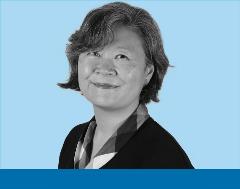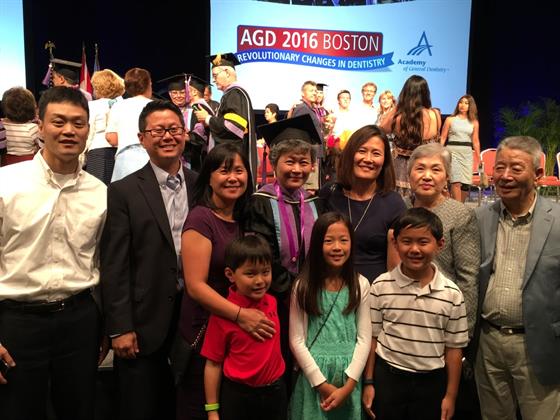Dr. Rhee Blazes a Trail Toward More Diverse Leadership in Dentistry
 In a 2020 interview for “AGD Leader Insider,” AGD’s monthly e-newsletter for constituent leaders, Region 2 Regional Director Seung-Hee Rhee, DDS, MAGD, said she felt compelled to become a volunteer leader after seeing the lack of female dentists in leadership roles and especially low representation from minority groups like Asian Americans. She overcame her feelings of fear and intimidation in order to represent those whose voices may not be heard otherwise. Now, she hopes her actions will inspire future generations of female dentists.
In a 2020 interview for “AGD Leader Insider,” AGD’s monthly e-newsletter for constituent leaders, Region 2 Regional Director Seung-Hee Rhee, DDS, MAGD, said she felt compelled to become a volunteer leader after seeing the lack of female dentists in leadership roles and especially low representation from minority groups like Asian Americans. She overcame her feelings of fear and intimidation in order to represent those whose voices may not be heard otherwise. Now, she hopes her actions will inspire future generations of female dentists. AGD Impact: Why did you become a dentist, and what has your professional journey been like?
Rhee: I had many role models and sources of inspiration that made me want to become a doctor when I was a child, from Dr. Leonard McCoy in “Star Trek” to the explorer Dr. David Livingstone to my neighborhood dentist, Dong Hwee Kye, DDS. However, my grandfather is the reason I became a dentist. When I was 8 years old, he told me he would like to see me grow up to become a doctor. Even when I got older, the dream stayed with me — to live my life helping others. Unfortunately, he passed away before I graduated, but I know he is proud of me.
After graduating from the New York University (NYU) College of Dentistry in 1996, I did a yearlong general practice residency at Jamaica Hospital Medical Center in Queens, New York, a level 1 trauma center, so I learned a lot about dealing with various emergencies. My first job after residency was at a District Council 37 Union dental clinic, where I worked for about 1.5 years before transitioning to private practice. At one point early in my career, I was working six days a week at four different practices. It was a great experience for me because I got to see and learn about various practice philosophies, and, ultimately, it led to my current practice in midtown Manhattan, where I have been happily practicing dentistry for the past 22 years. I started teaching part time at the NYU College of Dentistry in 2001 as a clinical instructor. It’s a lot more fun being faculty than a student at school. I currently hold the position of adjunct associate clinical professor in the Department of Cariology and Comprehensive Care. I teach mainly third- and fourth-year dental students in a clinical setting, and we see patients together.
The story of my professional journey would not be complete without AGD. I always tell my students the two best things I did to grow as a dentist and as a person were teaching at NYU and joining AGD. I joined AGD initially because I wanted to add a few more letters after my name to help distinguish me from other dentists, but, despite my ulterior motive, striving for my FAGD and MAGD made me a better dentist and helped me stay current in dentistry. My MAGD was tremendously meaningful to me because I received it soon after I finished treatment for breast cancer. My hair grew back just in time for the convocation!

How do you balance private practice, your faculty position at NYU and your leadership roles within AGD? Do you have any advice for other members who may be interested in wearing multiple hats within the profession?
I truly enjoy what I do. I feel very fortunate that I love my job and am living my childhood dream of being a doctor. I also firmly believe when something is important to you and when something is fun, you make the time, no matter how busy you are. Dentists already multitask and wear many hats even within the scope of our own practices (dentist, businessowner, teacher, adviser, etc.), so wearing multiple hats comes naturally for many dentists.
I highly recommend teaching for many reasons. First, to teach, you must know what you’re doing, perfect your clinical skills and stay on top of what’s going on in dentistry. Second, you run into so many more scenarios while teaching than you would in your own office. You end up learning a lot while teaching by encountering different patient populations and clinical situations. Third, teaching the next generation of dentists is an honor and a way for me to give back to the profession that has given me so much. My students keep dentistry fresh and interesting for me and, very often, they teach me a thing or two.
My advice for those who may be considering teaching or holding an AGD leadership position is to just do it. Sometimes, as dentists, we can get lost in our own little world of private practice, but it is important for us to be a part of something bigger in order to grow. I often tell my students, “A comfort zone is a wonderful place, but nothing ever grows there.” Go swim in the big pond for a change, and you can have the best of both worlds.
What do you think AGD can do as an organization to better support and encourage diversity among its volunteer leaders, and why is it important that AGD’s leadership better reflect the demographics of the profession?
Back in 2001, female dentists made up about 16% of all U.S. dentists according to data from the American Dental Association’s Health Policy Institute. That number has been growing every year. In 2020, female dentists made up 34.5% of dentists in the United States. That number is projected to be 44.2% by 2030 and 49.4% by 2040. In recent years at NYU, and I am sure at most dental schools in the United States, first-year dental student enrollment has been 50% female, if not higher. In 2020, female dentists made up 50.6% of dentists under the age of 35. The demographics of our profession are changing. Not only are more women entering dentistry, but there is more racial and ethnic diversity as well.
Asian Americans are an interesting group because, while we make up only about 5.7% of the U.S. population, when it comes to higher education, we make up about 10%–20% of the student population. Dentistry is no exception. As of 2018, 17.1% of dentists in the United States were of Asian background, and that number is growing. However, as you can see even in AGD’s own House of Delegates, there is a clear lack of diversity at the decision-making levels. Things are improving, though.
For AGD to survive as an organization, we must adapt to the changing environment, and visibility is a start to creating a supportive and encouraging environment for diversity among our volunteer leaders. I have noticed that AGD has been working hard in recent years — especially on our website, social media and print media — to showcase our members from various races, genders and ethnic backgrounds, and it is so wonderful to see. I also appreciate opportunities like this to tell my story. Who knows? There may be a young Asian American dentist out there who reads this and says, “Hey, she’s just like me. If she can do it, I can do it too!”
